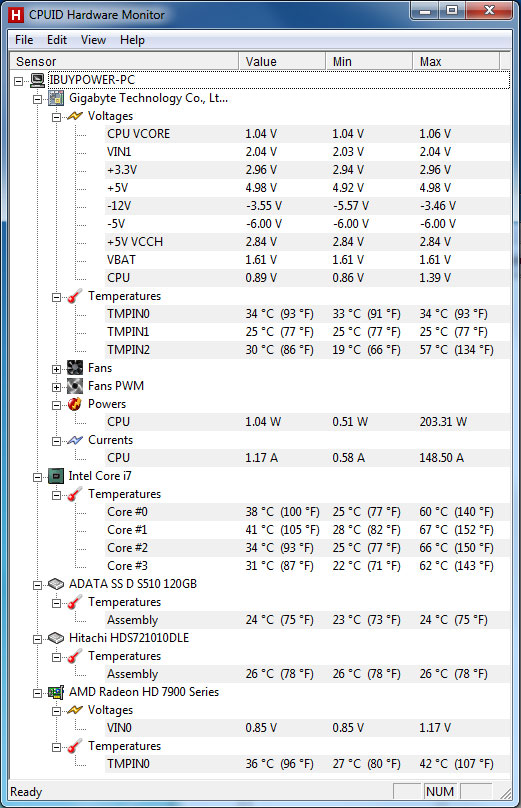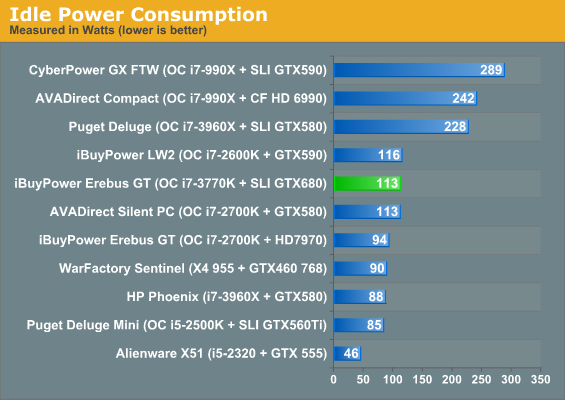iBUYPOWER Erebus GT Review: Ivy Bridge and NVIDIA's GeForce GTX 680 in SLI
by Dustin Sklavos on April 27, 2012 2:00 AM ESTBuild, Heat, and Noise
Given that the iBUYPOWER Erebus GT we have for review now is essentially identical in terms of build quality to the one we reviewed a month-and-a-half ago, there isn't a whole lot to update on. Build quality on this review unit was excellent, period, and the components iBUYPOWER chose were all solid, name brand selections. If anything, I think part of it might have been over-engineered.
Where things get interesting is when we look at system thermals and power draw. We've heard that Ivy Bridge runs hotter than Sandy Bridge does, and I can confirm those findings by comparing the thermal readings from our Sandy Bridge-based Erebus GT against our Ivy Bridge-based Erebus GT.

Intel Core i7-2700K-based Erebus GT

Intel Core i7-3770K-based Erebus GT
First, it's pretty obvious the water-cooling loop is doing its job on the video cards, and by doing so they give NVIDIA's GPU Boost a lot of thermal leeway. iBUYPOWER didn't overclock the GTX 680s in the Erebus GT, but odds are good you could probably eke out even more performance if you were somehow not satisfied with two GTX 680s in SLI. Second, the i7-3770K definitely runs hotter than the i7-2700K. Not by a tremendous degree, but there's a difference. Keep in mind that the ambient temperature in the room when testing the i7-3770K was closer to 21C, and definitely lower than it was when testing the i7-2700K.
Something to consider is that Ivy Bridge is a smaller chip than Sandy Bridge, but while it's more power efficient (see below), it's also more power dense. If we just use the base TDP, Sandy Bridge 4C is 95W in a 216mm2 die, for a power density of 0.44W/mm2. Ivy Bridge 4C by comparison is 77W in 160mm2, or 0.48W/mm2. That's only a 9% increase, but given how IVB reacts to overclocking and voltage, it's not too surprising that maximum reasonable overclocks are down for this first round of 22nm parts.
I'll say I'm not sure that HWMonitor's wattage readings are 100% accurate, either; the 203W it reports for the overclocked i7-2700K doesn't line up with our own power consumption test results, while HWMonitor reported between 50W and 70W for the i7-3770K. That's a little more believable given how frugal this configuration was with power in our test results, but still seems on the low side.
In terms of noise, it seems like someone heard my complaint about the fans in the first Erebus GT because this one comes with a fan controller. iBUYPOWER employs NZXT's six-channel analog fan controller, and it's very easy to adjust fan speeds to strike a good balance between noise and performance. I use the same controller in my own personal desktop.
Power Consumption
Where things get really exciting, actually, is in how much power this Erebus GT pulls from the wall. Keep in mind we're still dealing with a custom liquid-cooling loop, but thankfully iBUYPOWER applies an offset voltage that allows the system to idle properly.


Power consumption is, frankly, outstanding. Intel's i7-3770K, at least overclocked where it is in this system, still sips power, and the pair of GTX 680s are able to provide performance comparable to or better than a pair of GTX 590s at roughly half the power draw.
As a result, I honestly feel like the 1.2kW PSU is absolute overkill for the Erebus GT. It simply doesn't need it; a 750W unit would've done the job with plenty of headroom to spare. This configuration is incredibly efficient for the performance you get, so there's no need to waste the extra money on a huge power supply.


_thumb.jpg)
_thumb.jpg)
_thumb.jpg)
_thumb.jpg)
_thumb.jpg)
_thumb.jpg)








64 Comments
View All Comments
JarredWalton - Friday, April 27, 2012 - link
My "still need to find time to play" list right now includes:Mass Effect 3
Witcher 2
Fallout: New Vegas
Finish Skyrim
Finish Batman: Arkham City
If we go back to include games I really wanted to play but never got around to (and they're now collecting digital dust), add Bioshock 2, both Knights of the Old Republic games (I'm not even remotely interested in the new Star Wars: the Old Republic MMO, though -- not my type of time sink!), and dozens of others I can't think of right now. Thankfully, at least my work allows me the chance to play more games than most! LOL
UltimateKitchenUtensil - Saturday, April 28, 2012 - link
Koolance does offer low-fpi rads (better for low-speed fans, all else being equal), but not in a 3x140mm format -- so if iBUYPOWER uses only Koolance (because they might have a good relationship), they're stuck with the 30 fins per inch rad Koolance has.But for flow, that loop won't have a problem, at all -- there are no very restrictive blocks (like those silly motherboard blocks). Rads aren't restrictive, and the Koolance CPU block is a low-restriction component:
http://martinsliquidlab.org/2012/03/12/i7-3930k-cp...
Parallel might gain you a few degrees, but in the grand scheme of things it just won't matter.
shin0bi272 - Saturday, April 28, 2012 - link
thanks for the info. I figured that it would make some difference just by the logic of the water passing over the cpu then hitting the gpu. But the flow rate and temp of the water would obviously play a huge role in the raising of the temp. One other question. Where's the radiator (and its fan) on that system? Make that two questions... what is the tube at the back connected to and why? It looks like theres an expansion slot at the top with a connector going to it then connecting to the cpu and top gpu like theres supposed to be an external radiator or something coming out the back... but when you look at the back pic theres nothing coming out.UltimateKitchenUtensil - Saturday, April 28, 2012 - link
Actually, the loop goes:- Reservoir (in the bottom 5.25" bay)
- Pump (at the bottom of the case, next to the hard drive bays)
- GPU blocks, in series
- 1 x 140 mm Radiator on the back exhaust (that's what the tubes at the back are connected to -- the rad is the black rectangle between the fan and the back wall of the case)
- CPU block
- 3 x 140 mm Radiator in the roof, with the three top fans blowing on it.
- back to the Reservoir.
The tube that goes to the side of the roof, about half way from the front of the case, is for the Fill port, which is the round thing you see on the left side of the top of the case.
UltimateKitchenUtensil - Saturday, April 28, 2012 - link
And just for fun, if you wanted to build that loop out of Koolance stuff:- Reservoir TNK-501 - $80 - http://koolance.com/index.php?route=product/produc...
(there are much cheaper, but less featureful, reservoirs available elsewhere, though)
- Pump PMP-450 - $77 http://koolance.com/index.php?route=product/produc...
(also known as the Laing D5, you can find this pump rebranded by other companies, but $77 is reasonable)
- GPU blocks VID-NX680 - $130 x 2 - http://koolance.com/index.php?route=product/produc...
- 1 x 140 mm Radiator HX-CU-1401V - $50 - http://koolance.com/index.php?route=product/produc...
- CPU block CPU-370 rev. 1.1 - $80 - http://koolance.com/index.php?route=product/produc...
- 3 x 140 mm Radiator HX-CU-1403V - $75 - http://koolance.com/index.php?route=product/produc...
So main components = $622
You could save on the reservoir by going with something simpler (which it seems iBUYPOWER did), like this $35 XSPC:
http://www.frozencpu.com/products/2184/ex-res-104/...
However, you still need tubing (fairly cheap) and fittings (they get expensive relatively fast.
You need 2 fittings/component (unless they have built-in barbs, like the pump, or you use something like the tube that's between the GPUs).
For that system, you'd need something like 11 fittings, at $6.50 ea. for compression fittings:
http://koolance.com/index.php?route=product/produc...
+ adapters, the fill port, and video card connectors.
All told, that setup might cost around $750 if you bought the parts at retail.
Wreckage - Friday, April 27, 2012 - link
Ivy bridge and 680's vs Bulldozer CPU and Bulldozer 7970's.JarredWalton - Friday, April 27, 2012 - link
Why? To see Bulldozer get manhandled? Here are the gaming results at lower detail settings (e.g. to put the strain more on the CPU). These results are pertinent because when you move to SLI or CrossFire, the CPU becomes more limiting than the two GPUs in many games.http://www.anandtech.com/show/4955/the-bulldozer-r...
Here's another article that did Bulldozer vs. Nehalem vs. Sandy Bridge all with a single 7970:
http://www.techpowerup.com/reviews/AMD/HD_7970_CPU...
Unfortunately, the best the FX 8150 can do against Nehalem i7-920 and Sandy Bridge i5-2500K with a single 7970 is to match it in some titles, while on average even Nehalem tends to match or slightly exceed Bulldozer. That Sandy Bridge 2500K is 9% faster at 2560x1600 with a single GPU is pretty much all you need to know. Ivy Bridge will be even faster still (unless you're into overclocking, in which case it's pretty much a tie), all while consuming less power.
Here's another article on the subject, only with 3-way HD 6970 on i7-2600K and FX-8150. Warning: it's not pretty, unless you like Intel.
http://www.tweaktown.com/articles/4353/amd_fx_8150...
vailr - Friday, April 27, 2012 - link
The Asus Maximus V Formula Z77 board is due for release within the next 2 weeks or so, and includes a built-in water cooling loop for the power choke heat sinks. Would be interesting to see how water cooling with that board would affect overclockability. Will they (iBUYPOWER) be offering an updated Erebus GT using that Z77 board?UltimateKitchenUtensil - Saturday, April 28, 2012 - link
It will likely have very little effect -- you can already buy motherboard blocks, but they mostly exist for show -- people just use them because they can.saf227 - Friday, April 27, 2012 - link
"...a solid value and worthy of enthusiast attention."How can you say it's a solid value when you don't tell us a price? You don't even hint at a price (i.e. "Less than $3K").
So I'm going to ASSUME (since you give me no information to base a reasonable presumption on) that this system costs $25,000. And is therefore a TERRIBLE value.